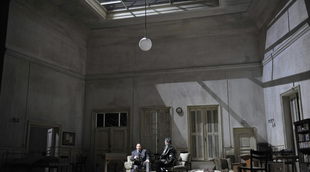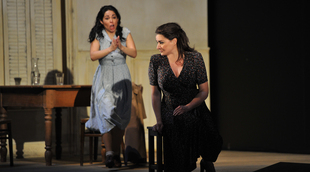 © Salzburg Festival
© Salzburg Festival
Cecilia Bartoli is not the type of singer modern audiences are used to hearing as Norma. La Scintilla isn’t the sort of orchestra we’re used to, either, and the Biondi/Minasi edition of the score used for this production includes surprises even for experienced Bellini aficionados. It’s daring to re-interpret the music of such a popular opera, but this project has clearly been painstakingly researched and carefully put together. In the hands of a superbly talented cast and a thoughtful directing team, this Salzburg Festival production convinces.

The setting is World War II-era occupied France, in a school that has been converted to a base for the resistance fighters. The many Druidic elements of the text read a bit oddly, but the overall story fits. The fighters have rituals and imbue their space with a sense of spiritualism, but Adalgisa’s and Norma’s real betrayal is not religious but political. As important members of the resistance, they are fraternizing with the enemy—a crime for which Norma will eventually have her hair shorn and be burned alive. The updated setting adds to the emotional immediacy of the opera; it’s easier to imagine and sympathize with the French resistance’s hatred for the Nazis than the Druids’ hatred for Romans.
Then again, nearly any setting would be effective with music this superb. The period group La Scintilla lends the score a light, sensitive sound. Under Giovanni Antonini’s baton, they are always well-paced and responsive to the singers. The Radiotelevisione Svizzera choir is perfectly balanced and blended. Surprisingly for an ensemble that does not generally perform in operas, they are also consummate actors. Their meltingly soft rendition of the rarely heard third section of ‘Guerra, guerra!’ was especially affecting.
Bartoli is the real revelation of the evening. Modern audiences are used to hearing dramatic Verdi and Wagner sopranos as Norma. The lighter sound of the orchestra and relatively small space have allowed this production to more closely match the original singers’ voices in casting. Bartoli’s consistently clear, precise, sparkling coloratura makes a strong case that Norma belongs to lyric bel canto singers. Her status as a mezzo is also unusual for the role; she proves it with uncommon richness and strength in her lower and mid-range but also shows off a top that is as good as any soprano’s, with lots of spin and the ability to bellow or float high notes at will. Bartoli wows most with her speed and flexibility in the showpiece ‘Casta Diva.’ But her warm tone, intense lyricism, and nuanced acting for the less ostentatious ‘Dormono entrambi’ and ‘Deh! Non volerli vittime’ make those scenes the most moving of the opera.

The rest of the cast is also composed of singers who wouldn’t normally be contracted for these roles but who sing them flawlessly. John Osborn sings Pollione in the voice of a classic Rossini tenor—bright, with an easy and flowing upper extension. His callous sarcasm in the first scene makes him hard to sympathize with at first, but his steadfastness and despair at the end win the audience over. Adalgisa is sung by Rebeca Olvera, a soprano who (in fitting with the text) looks and sounds much younger than Bartoli. Her lightness and sweetness of tone match her character’s youthful innocence. She and Bartoli have voices that mesh remarkably well despite their different textures. As Oroveso, Michele Pertusi sings with a full, earthy sound and shows poignant distress at his daughter’s betrayal and death.
When the schoolhouse goes up in flames (with marvelously executed pyrotechnics), it’s the satisfying, necessary end to the tragedy. But it’s also a shame—we could happily listen to this cast and orchestra for many hours more.
by Ilana Walder-Biesanz
the 01 of August, 2015 | Print
Comments